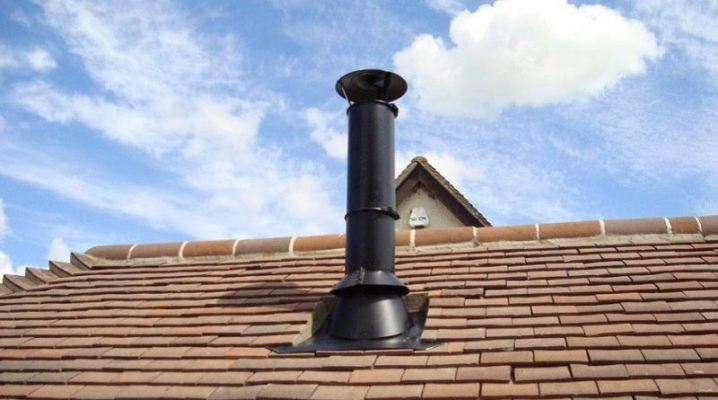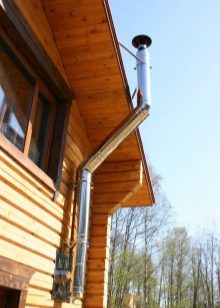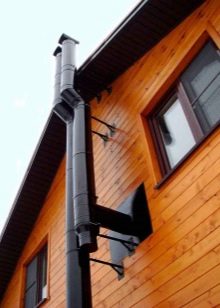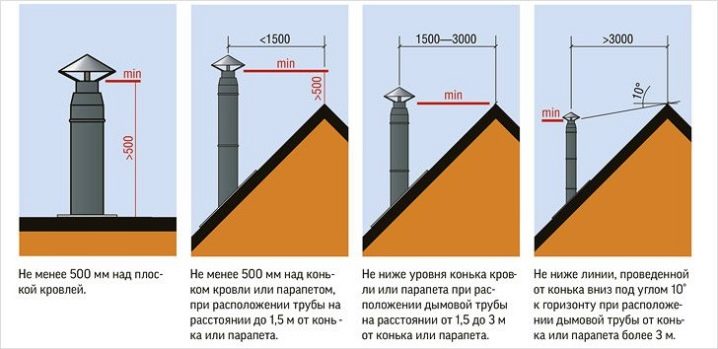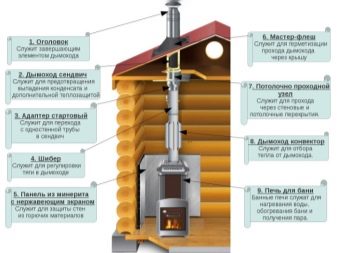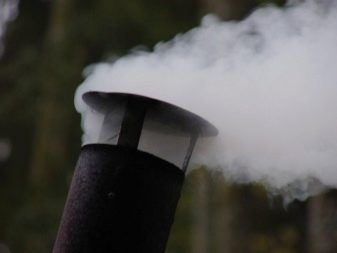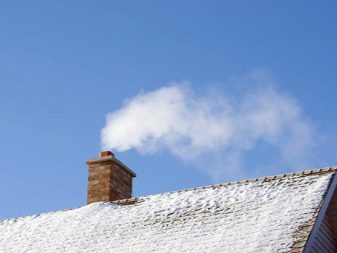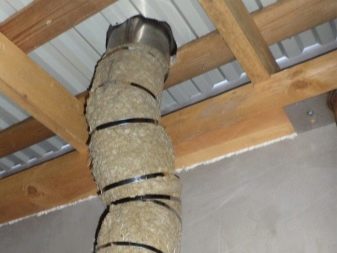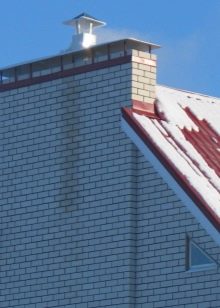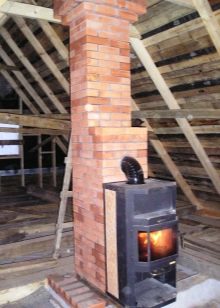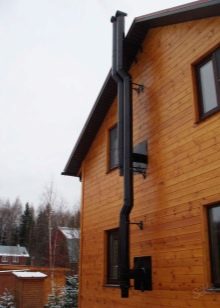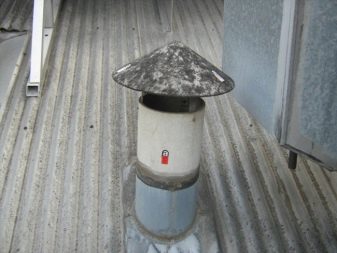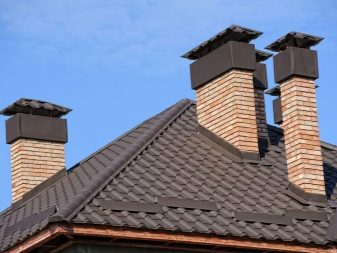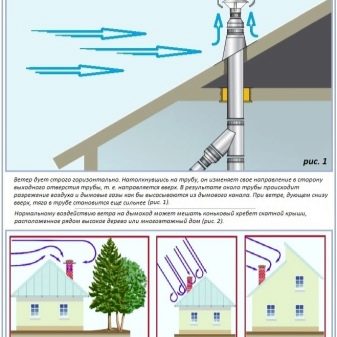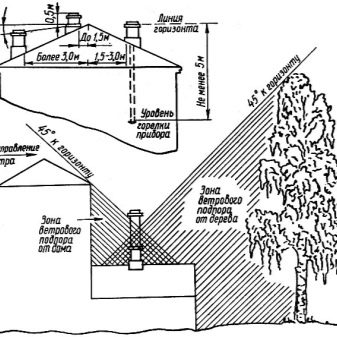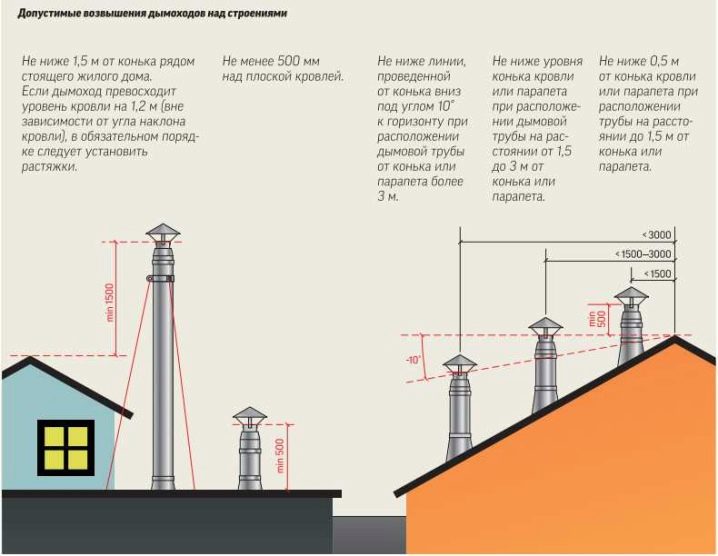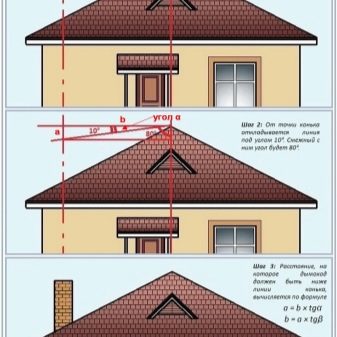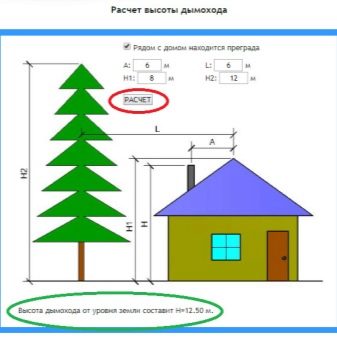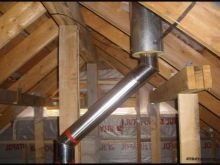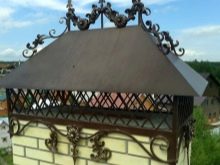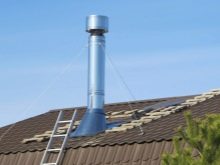Subtleties of the device chimney: how to calculate the height relative to the ridge of the roof?
When building a house, inside which there is a fireplace, a stove or any other heating equipment with solid fuel supply, in no case should we forget about the chimney, which is designed to remove combustion products from the house. When choosing its height relative to the ridge of the roof, it is necessary to take into account the norms for ensuring the escape of combustion products.
Features and requirements
In large cities, there is a bad environment and high rates of pollution, so the installation of the pipe should be done at a level slightly above the established norms and indicators. In small towns, standard standards can be used.
According to the fire safety requirements for the boiler room, the height of the pipe through the roof should be set as follows:
- if the chimney is located 1500 mm from the ridge of the roof, it must be installed at least 500 mm from the highest point of the roof;
- if the pipe is located 1500–3000 mm from the ridge of the roof, its level should correspond to the level of the roof;
- when the chimney is above 3000 mm from the ridge, it is installed below a 10-degree angle relative to the top of the roof;
- minimum chimney should be 1 m higher than the roof
Device
The pipe is mounted exactly and necessarily vertically. Deviation should be no more than 30 degrees per meter. But the internal section should not be subject to change.
If the chimney is made of brick, the brickwork is made dense, and the surface is carefully leveled from the inside, all remnants of the mortar must be carefully removed.
At the bottom, the chimney is equipped with a pocket with a door at least 20 cm deep, thanks to which the pipe can be cleaned of soot. In the ceilings between the floors around the chimney, fireproof insulation is arranged, with a wooden system it should be at least 30 cm, with concrete - 5 cm.
Advantages and disadvantages
The chimney has an increased efficiency due to a good pitting force. It can be installed not only in concrete houses, but also brick and wooden, as it complies with fire safety regulations. The advantages of the chimney also include the following characteristics:
- long service life;
- easy maintenance;
- soot settles on the walls in minimal quantities;
- the weight is small, so you do not need to make a powerful foundation;
- the chimney does not affect the area of the house;
- no need to make passes through the ceiling and the roof.
But the chimney has several negative properties. First of all, the fact that it is located on the street, respectively, is exposed to all weather conditions, sunlight, temperature drops. They adversely affect the design, which is why it must be further processed. Pipe fittings are installed in the wall, their sustainability should be given a lot of attention, otherwise they may collapse.
It should be borne in mind that the chimney must be insulated, which entails a lot of money.
Species
The location of the chimneys are as follows:
- wall - they are installed inside the main walls;
- radical - settled in a separate structure;
- external - installed on the facade of the house.
For brick buildings, experts recommend the use of wall chimneys, as they do not require the use of additional materials. A pipe of this type is produced independently along with the construction of a building. Heating equipment according to the method of removing gases is divided into structures with natural and forced pitch.
In the case of natural firing, the boiler is equipped with an in-built fan, while in the forced mode, it is created in the chimney. In the second case, experts recommend installing a small coaxial chimney.
Single-walled chimneys, which are made of stainless pipe with a thickness of 0.6 to 1.0 mm, are distinguished. They are installed inside the house or brick channels, their heat transfer provides the house with additional heat.
Double-walled pipes are made of two layers of stainless steel, between which set non-combustible insulation. The advantages of this design include temperature savings and a high rate of passage of gases.Condensate is practically not formed, and to the internal installation requirements are minimal. But this design is very high.
Materials
Chimneys are made of various materials. each of which has both advantages and disadvantages.
- Brick - such a chimney is characterized by durability, high heat capacity and safety. But the installation of such a construction takes quite a lot of time and requires considerable financial investments. The structure of a brick chimney is porous, because of the clay used on the walls, condensate accumulates, which negatively affects the device.
- Asbestos cement - suitable for gases whose temperature does not exceed +300 degrees. Installation is inexpensive and does not require much effort. It is worth noting the small weight of the structure. But such a chimney must often be cleaned of soot, besides it is not heat resistant.
- Ceramic - appeared on the market not so long ago, but as quickly as possible gained great popularity. It includes 3 components: refractory ceramics, non-combustible insulation and a concrete box.Among the advantages of a ceramic chimney it is necessary to highlight resistance to temperature, a circular cross section and a smooth surface, simple installation, long service life. But the installation will be expensive.
- Steel corrugated - it is made of a flexible pipe of steel tape. It is used for gilding curved chimneys of brick. It is easy to install and maintain, but not durable.
- Polymer - easy installation, low weight, flexibility and durability. It has no thermal insulation, and is also characterized by a low level of strength.
Form and section selection
When installing a pipe, it is worth paying attention not only to its height, but also to the cross-section and internal shape. It is round and rectangular. These characteristics are very important when operating heating devices and their efficiency. Everyone knows that warm air rises when heated. And the closer it is to the street, the faster it cools down - this is how the craving is created. Many people think that a large section of the pipe should provide good traction, but in reality this is not the case.
The larger the internal section, the faster the air cools, due to which condensation is formed in large quantities. Because of him, the quality of traction is far from the best.
From this it follows that if the pipe is made higher, its cross section decreases, the thrust will be too large, which will lead to loss of efficiency of the stove or fireplace. The supply of cold air from below will be increased, and there will not be a comfortable level of heat in the house. It will take more time and fuel to heat the room. If the chimney is high and the cross section is small, then this can lead to carbon monoxide and smoke getting into the private house.
To ensure the high-quality functioning of the heater and to avoid undesirable consequences, it is necessary to carefully carry out all calculations relating to the cross section using a special calculator. But it is best to invite experienced professionals.
The best form of the chimney is the cylinder. When the chimney works, the walls heat up unevenly, which is why smoke and carbon monoxide come out with a twist up along the central axis. If rectangular pipes are used, turbulence is formed in the corners that do not provide good traction. Chimney of this form is suitable for heating devices that do not require strong traction.
How to calculate?
To prevent undesirable consequences, it is necessary to accurately calculate the height of the chimney relative to the ridge of the roof. The dimensions of the pipe are influenced by such factors as:
- finding the chimney relative to the ridge of the roof;
- the angle of the roof;
- the location of buildings and trees near the building;
- weather.
Choosing the right height of the chimney, you need to pay attention to the following points:
- The height of the entire chimney should be at least 5 m. For houses without attics, a lower height is allowed;
- above the flat roof the pipe should rise at least 50 cm;
- if the distance from the exit of the chimney to the ridge edge varies from 1.5 to 3 m, then the head of the pipe should be flush with the roof or rise slightly above it;
- if skyscrapers are located nearby, then the chimney should be above the highest point of the nearby building.
Calculations on the height of the chimney relative to the ridge of the roof can be performed graphically in three steps such as:
- in the house drawing it is necessary to beat off the axes along the ridge and according to the intended location of the pipe;
- on top of the roof is set 10-degree angle.The line from the corner is held to the intersection with the axis of the chimney;
- if the resulting height meets all building codes, the chimney is installed at the designated place.
Independently perform the calculations is not difficult, but to avoid the malfunction of the pipeline, it is better to seek help from specialists. After all, one slightest mistake can lead to irreversible consequences.
Tips and tricks
Sometimes, in addition to a stove, a fireplace or a gas stove needs smoke in addition to a stove. Of course, for each appliance to bring the chimney is not an option. In this situation, experts recommend making a combined pipe with several channels, be sure to take into account the power of each device, as well as the type of fuel and the number of output products.
Given the general recommendations of professionals, you can achieve high-quality work and design devices, namely:
- when installing a brick chimney, the brickwork should be dense;
- so that there is not a big load on the building, in the attic provide a transition to the pipes;
- install a metal and asbestos pipe is recommended only vertically;
- so that dirt and birds do not get into the chimney, a special umbrella is put on the top;
- if the height of the structure is more than 1.2 m, it must additionally be fastened with braces.
The installation of heating appliances and chimneys is a difficult job, on which not only the heat in the room depends, but also the safety of people. Therefore, if you are not confident in your abilities, it is better to order the services of experienced specialists.
For information on how to choose and calculate the height of the chimney, see the video below.
